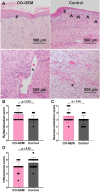Composite Hyaluronic Acid Gas-Entrapping Materials to Promote Wound Healing
- PMID: 39746190
- PMCID: PMC11733945
- DOI: 10.1021/acs.biomac.4c00904
Composite Hyaluronic Acid Gas-Entrapping Materials to Promote Wound Healing
Abstract
Tissue repair is often impaired in pathological states, highlighting the need for innovative wound-healing technologies. This study introduces composite hyaluronic acid gas-entrapping materials (GEMs) delivering carbon monoxide (CO) to promote wound healing in pigs. These composite materials facilitate burst release followed by sustained release of CO over 48 h. In a porcine full-thickness wound model, CO-GEMs significantly accelerated wound closure compared to the standard-of-care dressing (Tegaderm). Wound area closure with CO-GEMs was 68.6% vs 56.8% on day 14, 41.0% vs 25.1% on day 28, and 26.9% vs 11.8% on day 42, effectively reducing healing time by 14 days. Histological analysis revealed increased epithelialization and neovascularization with reduced inflammation. These findings demonstrate the potential of CO-GEMs as a topical therapeutic to enhance tissue repair in clinically relevant models, supporting further testing for wound-healing applications.
Copyright © 2025 The Authors. Published by American Chemical Society
Conflict of interest statement
The authors declare the following competing financial interest(s): EW, GT, LEO, DF, and JDB are co-inventors on multiple applications submitted by Brigham and Women’s Hospital, MIT, BIDMC, and the University of Iowa that covers therapeutic carbon monoxide formulations. GT, LEO, and JDB are co-founders of GEM Biosciences, a start-up company that focuses on the GeM technology. Complete details of all relationships for profit and not-for-profit for GT can be found at www.dropbox.com/sh/ szi7vnr4a2ajb56/AABs5N5i0q9AfT1IqIJAE-T5a?dl=0.
Figures




Similar articles
-
Topical antimicrobial agents for treating foot ulcers in people with diabetes.Cochrane Database Syst Rev. 2017 Jun 14;6(6):CD011038. doi: 10.1002/14651858.CD011038.pub2. Cochrane Database Syst Rev. 2017. PMID: 28613416 Free PMC article.
-
Dressings and topical agents containing hyaluronic acid for chronic wound healing.Cochrane Database Syst Rev. 2023 Jul 27;7(7):CD012215. doi: 10.1002/14651858.CD012215.pub2. Cochrane Database Syst Rev. 2023. PMID: 37497805 Free PMC article.
-
Characterization and biological evaluation of melatonin-loaded silk fibroin-hyaluronic acid films for multifunctional wound dressings.Int J Pharm. 2025 Aug 20;681:125830. doi: 10.1016/j.ijpharm.2025.125830. Epub 2025 Jun 8. Int J Pharm. 2025. PMID: 40494453
-
Synthesis of a retro-GFOGER Adamantane-Based Collagen Mimetic Peptide Imbibed in a Hyaluronic Acid Hydrogel for Enhanced Wound Healing.ACS Appl Bio Mater. 2025 Jun 16;8(6):4657-4672. doi: 10.1021/acsabm.4c01895. Epub 2025 Feb 19. ACS Appl Bio Mater. 2025. PMID: 39970309 Free PMC article.
-
Antibiotics and antiseptics for surgical wounds healing by secondary intention.Cochrane Database Syst Rev. 2016 Mar 29;3(3):CD011712. doi: 10.1002/14651858.CD011712.pub2. Cochrane Database Syst Rev. 2016. PMID: 27021482 Free PMC article.
Cited by
-
Carbon monoxide potentiates the effect of corticosteroids in suppressing inflammatory responses in cell culture.Bioorg Med Chem. 2025 Apr 1;120:118092. doi: 10.1016/j.bmc.2025.118092. Epub 2025 Jan 31. Bioorg Med Chem. 2025. PMID: 39904198
References
-
- Elraiyah T.; Domecq J. P.; Prutsky G.; Tsapas A.; Nabhan M.; Frykberg R. G.; Hasan R.; Firwana B.; Prokop L. J.; Murad M. H. A systematic review and meta-analysis of débridement methods for chronic diabetic foot ulcers. J. Vasc. Surg. 2016, 63 (2), 37S–45S.e2. 10.1016/j.jvs.2015.10.002. - DOI - PubMed
Publication types
MeSH terms
Substances
Grants and funding
LinkOut - more resources
Full Text Sources

